Enrico Fermi
Biographies - Enrico Fermi
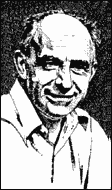 Enrico
Fermi, born in Rome, Italy on September 29, 1901.
Before emmigrating from Fascist Italy, Fermi
developed the theory of beta decay and did
experiments where he bombarded elements with
neutrons which produced artificial radiation. He
was awarded for his latter work with a nobel
prize in 1938. After fleeing Italy with his wife
(who was Jewish) to the United States, he became
a physics professor at Columbia University. This
was where he created the first sustained nuclear
fission chain reaction. He also worked on the
atomic bomb (the Manhatten Project) but later
opposed it due to ethical reasons. He died of
stomach cancer on November 28, 1954 in Chicago. Enrico
Fermi, born in Rome, Italy on September 29, 1901.
Before emmigrating from Fascist Italy, Fermi
developed the theory of beta decay and did
experiments where he bombarded elements with
neutrons which produced artificial radiation. He
was awarded for his latter work with a nobel
prize in 1938. After fleeing Italy with his wife
(who was Jewish) to the United States, he became
a physics professor at Columbia University. This
was where he created the first sustained nuclear
fission chain reaction. He also worked on the
atomic bomb (the Manhatten Project) but later
opposed it due to ethical reasons. He died of
stomach cancer on November 28, 1954 in Chicago.
http://grotto.virtualave.net/bios/fermi.html
Enrico Fermi
While studying the creation of
artificially radioactive isotopes in the 1930s,
Enrico Fermi became the first physicist to split
the atom. His later research pioneered nuclear
power generation.
http://www.invent.org/book/book-text/42.html
Enrico Fermi
Enrico Fermi was born in Rome on
September 29, 1901. He is best known for his
contributions to nuclear physics and the
development quantum theory. In 1934, while
professor of physics at the University of Rome,
Fermi began experiments where he bombarded a
variety of elements with neutrons. He discovered
that slow moving neutrons were especially
effective in producing radioactive atoms. Not
realizing he had split the atom, Fermi announced
what he thought were elements beyond uranium. He
won the 1938 Nobel Prize for
physics for his work on nuclear processes. Also
in 1938 two German physicists, Lise Meitner and
Otto Frisch performed a similar experiment where
they split a uranium atom. They named the process
of splitting atoms "nuclear fission."
http://www2.lucidcafe.com/lucidcafe/library/95sep/fermi.html
Enrico Fermi
(b. Sept. 29, 1901, Rome--d. Nov.
28, 1954, Chicago), Italian-born U.S. physicist
who was one of the chief architects of the
nuclear age. He developed the mathematical
statistics required to clarify a large class of
subatomic phenomena, discovered neutron-induced
radioactivity, and directed the first controlled
nuclear chain reaction. He was awarded the 1938
Nobel Prize for Physics, and the Enrico Fermi
Award of the U.S. Department of Energy is given
in his honour. (see also Index: subatomic
particle, nuclear
reaction)
http://pc9805.dmacc.cc.ia.us/humn133/subjects/science/Fermi.html
Enrico Fermi Winner of the 1938 Nobel
Prize in Physics
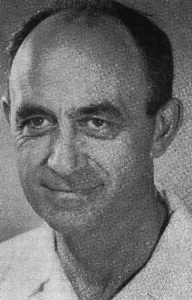 1938 Nobel
Laureate in Physics for his demonstrations of the
existence of new radioactive elements produced by
neutron irradiation, and for his related
discovery of nuclear reactions brought about by
slow neutrons. 1938 Nobel
Laureate in Physics for his demonstrations of the
existence of new radioactive elements produced by
neutron irradiation, and for his related
discovery of nuclear reactions brought about by
slow neutrons.
http://www.nobelprizes.com/nobel/physics/1938a.html
Enrico Fermi
Enrico Fermi's first significant
accomplishment in nuclear physics was providing a
mathematical means for describing the behavior of
certain types of subatomic particles, a process
concurrently developed by Paul Dirac and which
came to be known as Fermi-Dirac statistical
mechanics. His next major accomplishment was to
successfully explain beta decay by incorporating
into the process the production of a new particle
which he named the neutrino. Despite the
significance of his contributions to theoretical
physics, Fermi is best known for his experimental
work. For his discovery of new radioactive
elements and his work with slow neutrons, Fermi
was awarded the 1938 Nobel Prize in physics.
However, unknown to Fermi and the Nobel Prize
Committee, the "new elements" Fermi
characterized (with one exception) weren't new at
all, they were fission products, i.e.,
radioisotopes of known elements produced by
splitting uranium.
http://www.orcbs.msu.edu/radiation/radhistory/enricofermi.html
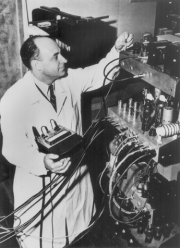 ESVA: Fermi Mini-Exhibit ESVA: Fermi Mini-Exhibit
"Whatever nature has in
store for mankind, unpleasant as it may be, men
must accept, for ignorance is never better than
knowledge." -- Enrico Fermi
http://www.aip.org/history/esva/exhibits/fermi.htm
Enrico Fermi
Enrico Fermi produced the world's
first controlled chain reaction at the University
of Chicago's Metallurgical Laboratory on December
2, 1942. This event, often considered to be the
beginning of the nuclear age, led to the work
done at Los Alamos during World War II. Fermi
joined the wartime staff at Los Alamos, where he
later helped build the first nuclear reactor,
known as "Water Boiler."
http://physics.hallym.ac.kr/reference/physicist/Fermi.html
A Science Odyssey: People and
Discoveries: Fermi creates controlled nuclear
reaction
Fermi, among others, realized that
nuclear fission was accompanied by the release of
colossal amounts of energy from the conversion of
mass into energy (according to Einstein's
mass-energy equation E=mc2). When
scientists convinced President Roosevelt of this,
Fermi was appointed to head a research team as
part of a secret project to develop an
atomic bomb. Fermi's task, however,
was to create a controlled nuclear reaction; that
is, to split the atom without creating a deadly
explosion.
http://www.pbs.org/wgbh/aso/databank/entries/dp42fe.html
Alligators nuclear Weapons Page
zvi@zvis.com
The most destructive weapon ever
created by mankind, on the other hand, they kept
peace during last 50 years and of course such a
weapon couldn't be created without the most
brilliant scientists. Einstein, Bohr, Sczillard,
Fermi, Feynman, Oppenheimer, Carter - those are
the ones who created that weapon. As Enrico Fermi
said once - "First of all this is a very
interesting physics", yeah, it is, but it is
also pretty much deadly thing.
http://www.zvis.com/gatornuk.shtml
Fermi Biography Page
webmaster@fnal.gov
Enrico Fermi was born in Rome,
Italy, on September 29, 1901. He died November
28, 1954. 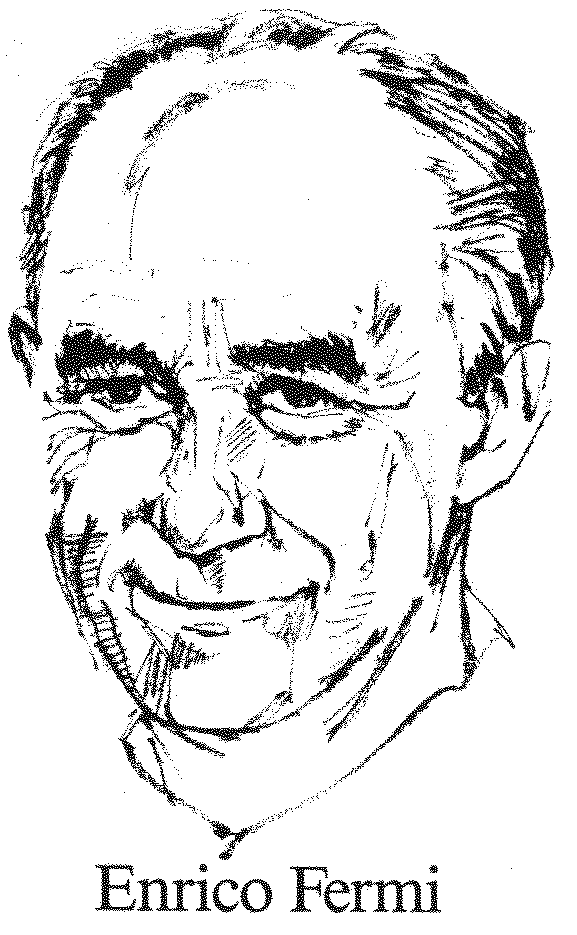 Fermi's
accomplishments were in both theoretical and
experimental physics, a unique feat in an age in
which scientific endeavors have tended to
specialize on one aspect or the other. In 1933,
he developed the theory of beta decay,
postulating that the newly-discovered neutron
decaying to a proton emits an electron and a
particle which he called a "neutrino".
The theory developed to explain this interaction
later resulted in recognition of the weak
interaction force. Investigation into the weak
force has been one of the major areas of study at
Fermilab. Fermi's
accomplishments were in both theoretical and
experimental physics, a unique feat in an age in
which scientific endeavors have tended to
specialize on one aspect or the other. In 1933,
he developed the theory of beta decay,
postulating that the newly-discovered neutron
decaying to a proton emits an electron and a
particle which he called a "neutrino".
The theory developed to explain this interaction
later resulted in recognition of the weak
interaction force. Investigation into the weak
force has been one of the major areas of study at
Fermilab.
Fermi received the Nobel Prize in 1938 for
"his discovery of new radioactive elements
produced by neutron irradiation, and for the
discovery of nuclear reactions brought about by
slow neutrons." At that time it was
recognized that nuclear fission (the splitting of
the atom) had taken place in Fermi's and other
similiar experiments. Scientists felt that this
principle might be applied to construct an
"atomic bomb". Fermi moved to the
University of Chicago to be in charge of the
first major step in making feasible the building
of a bomb. In the squash courts under the west
stand of the University's Stagg Field, Fermi
supervised the design and assembly of an
"atomic pile", a code word for an
assembly that in peacetime would be known as a
"nuclear reactor".
At
the end of World war II, the University of
Chicago formed its Institute for Nuclear Studies
(now named The Enrico Fermi Institute), to keep
together the gifted scientists who had worked on
the development of the atom bomb. To Fermi high
energy physics was the most exciting area of
physics. He accurately predicted that giant
accelerators (such as Fermilab's) would be built
in the future. In lighter moments, he even
dreamed of an accelerator that would be built at
the equator and encircle the globe!
http://www.fnal.gov/pub/fermi_biography.html
Fermi Takes Charge
In New York City in 1940,
Enrico Fermi continued to conduct nuclear fission
experiments at 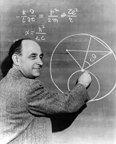 Columbia
University. Fermi's team, including Leo Szilard
and Walter Zinn, confirmed that absorption of a
neutron by a uranium nucleus can cause the
nucleus to split into two nearly equal parts,
releasing several neutrons and enormous amounts
of energy. The potential for a self-sustaining
nuclear chain reaction had become a strong
possibility. Columbia
University. Fermi's team, including Leo Szilard
and Walter Zinn, confirmed that absorption of a
neutron by a uranium nucleus can cause the
nucleus to split into two nearly equal parts,
releasing several neutrons and enormous amounts
of energy. The potential for a self-sustaining
nuclear chain reaction had become a strong
possibility.
Enrico Fermi, the last universal scientist.
Arthur Compton recalled his visit to Columbia to
invite Fermi to join the Met Lab project: Fermi
stepped to the blackboard and worked out
"simply and directly the equation from which
could be calculated the critical size of a
chain-reaction sphere."
http://www.anl.gov/OPA/frontiers96/unisci.html
Fermi, Enrico (1901-1954)
Italian physicist who created the
first controlled Chain
Reaction in 1943 and founded Argonne
National Laboratory.
http://www.treasure-troves.com/bios/Fermi.html
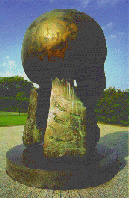 Manhattan Project - Enrico Fermi - Henry
Moore Sculpture Manhattan Project - Enrico Fermi - Henry
Moore Sculpture
"On December 2, 1942, man
achieved here the first self-sustaining chain
reaction and thereby initiated the controlled
release of nuclear energy." Chicago Pile No.
1 (CP-1) was constructed in a makeshift
laboratory under the grandstands of Stagg Field
Stadium at The University of Chicago. In 1965,
the site was designated a registered national
historic landmark. The sculpture was dedicated in
1967 on "the 25th anniversary of the first
controlled generation of nuclear power, an
experiment by Enrico Fermi and his
colleagues."
http://physics.uchicago.edu/moore_statue.html
SJSU Virtual Museum
Enrico Fermi was born in Rome, Italy
on September 29, 1901. Enrico Fermi was awarded
the Nobel Prize in physics in 1938 for his work
in bombarding elements with neutrons to produce
artificial radioactivity. Fermi died of cancer in
1954 in Chicago, Illinois.
http://www.sjsu.edu/depts/Museum/fer.html
|



